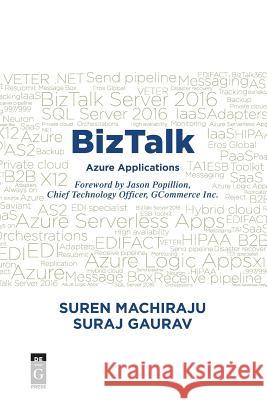BizTalk: Azure Applications » książka



BizTalk: Azure Applications
ISBN-13: 9781501514760 / Angielski / Miękka / 2018 / 340 str.
BizTalk: Azure Applications
ISBN-13: 9781501514760 / Angielski / Miękka / 2018 / 340 str.
(netto: 249,74 VAT: 5%)
Najniższa cena z 30 dni: 237,34
ok. 16-18 dni roboczych
Dostawa w 2026 r.
Darmowa dostawa!
Foreword
Chapter 1: Evolution of BizTalk 1
Component Object Model (COM) 1
Programming Languages for COM Components 2
Microsoft Transaction Server (MTS) 2
MTS Explorer 3
Distributed Component Object Model (DCOM) 4
Language Independent 5
Protocol Independent 5
Garbage Collection 5
Reusability 5
Microsoft Site Server 1.0 6
Microsoft Merchant Server 7
Microsoft Site Server 2.0 7
Microsoft Commerce Server 8
Electronic Data Interchange (EDI) 8
First EDI Message 9
Transportation Data Coordinating Committee (TDCC) 9
First EDI Standard, SWIFT, and EDIA 10
EDIFACT 10
EDI Today 11
BizTalk Server 11
BizTalk Server 2000 11
BizTalk Server 2002 12
BizTalk Server 2004 12
Covast 13
BizTalk Server 2006 17
BizTalk Server 2006 R2 17
BizTalk Server 2009 18
BizTalk Server 2010 18
BizTalk Server 2013 19
BizTalk Server 2013 R2 20
BizTalk Server 2016 20
BizTalk Server 2016 Feature Pack 1 21
BizTalk Server 2016 Feature Pack 2 22
Windows Azure BizTalk Services (WABS) 23
Azure BizTalk Services 23
Summary 24
Chapter 2: BizTalk Integration Patterns 25
Enterprise Application Integration (EAI) 25
Orchestration 29
Exploring Orchestration Design Surface 31
Business to Business (EDI, HIPAA, and XML) 32
Electronic Data Interchange (EDI) 32
Health Insurance Portability and Accountability Act (HIPAA) 33
XML 34
B2B and EAI with BizTalk 34
Implementing the Process through BizTalk 37
Summary 49
Chapter 3: BizTalk Server 2016 Features 51
New and Enhanced Features of BizTalk Server 2016 51
Exploring the Features Related to EAI Integration 52
Artifacts Analytics Tracking 52
Azure Logic Apps Adapter 61
Support for SAP .NET Connector (NCo) 77
Connect to SQL Server Always Encrypted Column from BizTalk
Server 77
Exploring the Features Related to Business Process Control
Integration 84
Map Compilation 85
Ordered Delivery on Dynamic Send Ports 87
Advanced Location Scheduling 88
Exploring the Features Related to the Business to Business
Integration 90
Connecting to Azure File Share from BizTalk File Adapter 90
Refined B2B Import/Export Process 98
Improved FTP and SFTP Adapters 102
Exploring the Improvements to Miscellaneous/UI Features 104
Simultaneous Configuration of Multiple Hosts/Host Instances 105
Searching Artifacts 106
Save Multiple Suspended Messages Simultaneously 106
Connect to Management REST APIs 107
Operational Data Feed for Power BI 108
Resizable Schema Window 112
BizTalk Server 2016 Azure VMs in Production 113
Summary 114
Chapter 4: BizTalk in Microsoft Azure Services 115
BizTalk Infrastructure as a Service 115
BizTalk Integration Platform as a Service 116
Azure Logic Apps 116
Integration Account 118
Hybrid Connections 138
EAI Implementation Using BizTalk Azure Services 138
Building Required Artifacts 139
Implementing Workflow in Azure Logic Apps using Integration
Account 143
Testing the Workflow 144
Extending the Scenario using Hybrid Connection 146
Summary 154
Chapter 5: Web 3.0, Custom BizTalk Azure Application 155
Introduction 155
BizTalk Alternatives 155
Pipeline Processing Alternatives 155
Transformation Alternatives 158
Orchestration/Workflow Alternatives 159
A Simple Stateless End-to-End Process Implementation Using
Alternatives 161
Windows Service 162
The FileSystemWatcher Component 163
Configuration File 164
Moving to Business Process 165
Transform/Mapping 166
Code Implementation 171
Installing Order Processing Service 173
Testing the Order Processing Service 175
Extending the Scenario (EDI Processing and Persistence) 178
EDI Processing 179
Persistence Scenario 180
Implementation 181
Testing the Extended Scenario 196
Extending a Bit More: Generate ACK 199
Summary 202
Chapter 6: Compare Azure BizTalk Applications: BizTalk IaaS, BizTalk PaaS, and
Custom Integration 203
Introduction 203
Key Comparison Pivots 203
Application Integration Capabilities 204
Long-Running Transactions 204
Dynamic Message Processing and Routing 207
Business Rules Execution 208
Workflow Support 210
End-to-End Transactional Support 211
Tracking System 212
EDI Business Processes 215
Message Protocol Support 215
Protocol and Line of Business Connectors 216
Developer Experience 217
Scalability 218
Maintainability 220
Ease of Implementation 220
Cost of Ownership 221
Summary 224
Chapter 7: Partner Solutions for BizTalk Azure Applications 227
Introduction 227
BizTalk360 227
Operations 231
Monitoring 246
Analytics 249
WPC (WPC-EDI) 252
HIPAA Database Toolkit 252
Installing Database Toolkit 253
Enabling the CLR in the SQL Server 255
Generating EDI (Version 5010) Transaction DDL Scripts 255
Using DDL Script to Configure EDI Transaction Database 256
Using the Database Toolkit (DBToolKit) Adapter 259
Neudesic 264
What is Enterprise Service Bus (ESB)? 265
BizTalk ESB Toolkit 265
BizTalk ESB Toolkit Components 265
Installation 266
Configuring ESB Toolkit 268
Configuring ESB BizTalk Applications 270
ESB Management Portal 272
BizTalk ESB Implementation 277
Implementing Dynamic Routing Based on Message Type 277
Creating an ESB Itinerary Application 283
Defining the Sequence of Execution (Using Connectors) 291
Validating the Itinerary 292
Deploying the Itinerary 293
Testing ESB Implementation 295
Summary 297
Chapter 8: Summary-Three Valuable BizTalk Azure Application
Options 299
Introduction 299
History of BizTalk 299
BizTalk Integration Patterns 300
Features of BizTalk Server 2016 301
BizTalk in Microsoft Azure Services 303
Web 3.0 as a BizTalk Alternate 303
Compare BizTalk IaaS, BizTalk PaaS, and Custom Integration 305
Microsoft Partners in BizTalk Domain 307
Conclusion 308
Index 309
Suren Machiraju, Suraj Gaurav
1997-2025 DolnySlask.com Agencja Internetowa
KrainaKsiazek.PL - Księgarnia Internetowa









